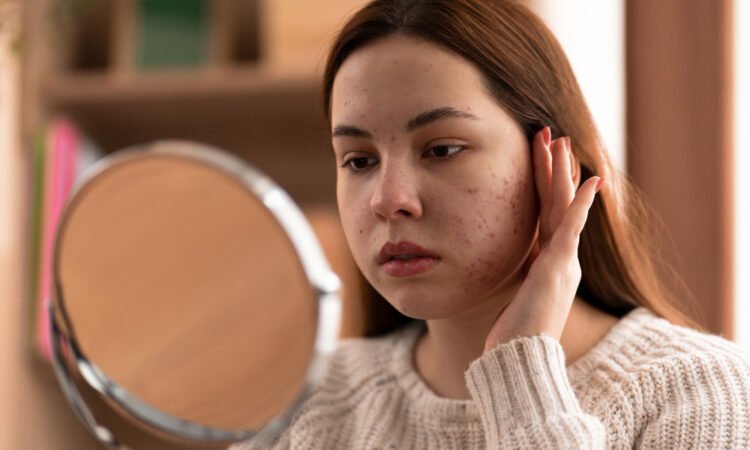
Hyperpigmentation refers to the darkening of certain areas of the skin due to an excess production of melanin, the pigment responsible for skin color. While it’s essential to consult with a dermatologist for personalized treatment options, here are some common remedies and practices that may help reduce the appearance of hyperpigmentation:
- Sun Protection: Protecting your skin from harmful UV rays is crucial in managing hyperpigmentation. Use broad-spectrum sunscreen with SPF 30 or higher, wear protective clothing, and avoid prolonged sun exposure, especially during peak hours.
- Topical Treatments:
- Hydroquinone: Over-the-counter or prescription hydroquinone creams can help lighten dark spots by inhibiting melanin production.
- Retinoids: Topical retinoids, such as tretinoin (Retin-A), can promote skin cell turnover and fade hyperpigmentation over time.
- Vitamin C: Products containing vitamin C can help brighten the skin and reduce the appearance of dark spots.
- Alpha Hydroxy Acids (AHAs) and Beta Hydroxy Acids (BHAs): AHAs like glycolic acid and BHAs like salicylic acid can exfoliate the skin, improving its texture and reducing pigmentation.
- Chemical Peels: In-office chemical peels performed by dermatologists can help exfoliate the outer layer of the skin, reducing hyperpigmentation and promoting cell turnover.
- Microdermabrasion: This procedure involves exfoliating the skin with tiny crystals to remove the outer layer of dead skin cells, revealing smoother and more even-toned skin.
- Laser Therapy: Various laser treatments, such as intense pulsed light (IPL) therapy and fractional laser therapy, can target and lighten hyperpigmented areas of the skin.
- Natural Remedies:
- Licorice Extract: Contains glabridin, which inhibits melanin production and can help lighten dark spots.
- Niacinamide (Vitamin B3): Has anti-inflammatory properties and can help reduce hyperpigmentation.
- Aloe Vera: Soothes the skin and may help fade dark spots over time.
- Green Tea Extract: Contains antioxidants that can help reduce inflammation and lighten pigmentation.
- Consistent Skincare Routine: Establish a daily skincare routine that includes gentle cleansing, exfoliation, moisturization, and sun protection to maintain healthy and even-toned skin.
- Professional Consultation: If over-the-counter remedies do not provide satisfactory results, consider consulting with a dermatologist or skincare professional for personalized treatment options, including prescription medications or procedures.
It’s essential to be patient and consistent with any treatment regimen for hyperpigmentation, as it may take time to see noticeable improvements. Additionally, practice good skincare habits and sun protection to prevent further darkening of the skin.

The effectiveness of massage in treating hyperpigmentation directly is limited, as hyperpigmentation is primarily a condition of melanin distribution in the skin. However, massage can indirectly contribute to improving the appearance of hyperpigmentation by promoting circulation, lymphatic drainage, and overall skin health. Here’s a massage technique that may help:
Lymphatic Drainage Massage:
Description: Lymphatic drainage massage is a gentle and rhythmic massage technique designed to stimulate the lymphatic system, which helps eliminate toxins and waste from the body. By improving lymphatic circulation, this massage technique can promote detoxification and reduce inflammation, potentially aiding in the improvement of skin tone and texture, including areas affected by hyperpigmentation.
Steps:
- Begin by applying a small amount of facial oil or lotion to clean, dry skin.
- Gently massage the face and neck using light pressure and circular motions, moving in the direction of lymphatic flow.
- Start at the center of the face and work outward towards the ears, then move down the sides of the neck towards the collarbones.
- Use gentle tapping or light pumping motions with your fingertips to encourage lymphatic drainage.
- Repeat each movement several times, focusing on areas of concern or areas with noticeable hyperpigmentation.
- Take care to avoid applying too much pressure, especially around delicate areas like the eyes.
- Continue the massage for 5-10 minutes, or longer if desired, to fully stimulate lymphatic circulation and promote detoxification.
- Finish by gently patting the skin with your fingertips to promote absorption of any remaining product.
Frequency: For best results, perform lymphatic drainage massage regularly as part of your skincare routine, ideally a few times per week. Consistency is key to maintaining lymphatic health and supporting overall skin wellness.
While massage can complement other treatments for hyperpigmentation, such as topical creams or professional procedures, it’s essential to consult with a dermatologist or skincare professional for personalized recommendations tailored to your specific skin concerns. Additionally, remember to use sun protection daily to prevent further darkening of hyperpigmented areas and promote skin healing.




